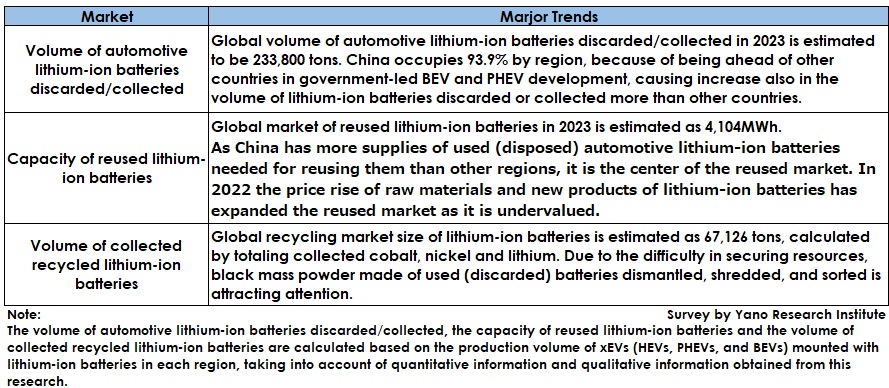No.3330
Global Trends of Reusing and Recycling of Lithium-ion Batteries 2023
The Market is Currently in Recycling Boom. Optimal Mechanism Foreseeing Beyond the Boom is What to Aim for
Yano Research Institute (the President, Takashi Mizukoshi) carried out a survey on the global trends of reusing and recycling of lithium-ion batteries.

Market Overview
With the market expansion of battery-powered electric vehicles (BEVs) and plug-in hybrid electric vehicles (PHEVs), automotive lithium-ion batteries worldwide have shown increase in their production bases and reinforcement in production capacities. Therefore, it is imperative to deploy a mechanism for reusing and recycling the ever-increasing lithium-ion batteries.
In politics, the European Union, in its new battery regulations that are finalized, includes “mandatory use of recycled materials”, while the United States, in its Inflation Reduction Act (IRA), has included “the use of critical minerals extracted, processed, or recycled in the US or those countries that have concluded FTA or critical minerals agreement” as one of the conditions for EV buyers to earn tax credit. In addition, soaring prices of nickel (Ni), cobalt (Co), lithium (Li), etc., that are used in lithium-ion batteries have led to reconfirm the significance of recycling the batteries in terms both of value and securing. Against this backdrop, the interest in reusing and recycling of lithium-ion batteries continues rising.
Noteworthy Topics
Status of Disposal and Collection of Automotive Lithium-ion Batteries
The global volume of automotive lithium-ion batteries discarded/collected in 2023 is estimated to be 233,800 tons. When observing this by region, China occupies 93.9%. It is because the country has been ahead of others in BEV and PHEV development led by the government, causing increase in the volume of lithium-ion batteries discarded or collected to be also ahead of other countries.
The expanding period for the discarded and collected volume of automotive lithium-ion batteries has been much later than first projected. For instance, in Japan, the BEV or PHEV sales are small, with used vehicles being exported. In China, the government-led traceability-system initiative is not working well, while there is an influx of used lithium-ion batteries aside from those discarded by whitelist companies certified by the country, causing the volume of the batteries collected to be smaller than expected. In Europe, there is a "missing vehicle" issue where xEVs are lost somewhere. In the US, there is no rules for collecting automotive lithium-ion batteries and has been only collected individually. These situations are preventing from expanding the volume of automotive lithium-ion batteries to be collected.
Future Outlook
Reusing and recycling of lithium-ion batteries are measured by new and old values, i.e., carbon neutrality and economic rationality, and foreseeing the future involves multiple variables.
New batteries regulation by the EU targets the carbon footprints throughout the product lifecycles, so that the value to reduce CO2 emissions in recycling processes may become higher.
Nevertheless, recycling processes for reducing CO2 emissions have the aspect of being costly and seem to require long time for consumers to widely accept the added costs and the changes of current sense of values. In addition, some efforts with diverse viewpoints are needed for lithium-ion battery recycling, including the fact that the source of recycling will eventually be those used (discarded) lithium-ion batteries from the market.
There is no denying that the current attention to reusing and recycling of lithium-ion batteries is somewhat too enthusiastic. As time goes by as this feverishness fades away, it is possible that in a few years there may be a phase at which people can reconsider the situation calmly and optimally.
Research Outline
2.Research Object: Business and technologies that reuse and recycle lithium-ion batteries (small consumer-use batteries, automotive batteries, and energy storage systems)
3.Research Methogology: Face-to-face interviews by expert researchers (including online) and literature research
Reusing and Recycling of Lithium-ion Batteries
Reusing and recycling of lithium-ion batteries in this research refer to secondary use of unnecessary lithium-ion batteries after being disposed of or being replaced, and to recycle cobalt, nickel, and other metal ingredients extracted from used-up batteries into new materials for cathode components and for other applications.
The volume of automotive lithium-ion batteries discarded/collected, the capacity of reused lithium-ion batteries and the volume of collected recycled lithium-ion batteries are calculated based on the production volume of xEVs (HEVs, PHEVs, and BEVs) mounted with lithium-ion batteries in each region, and the volume of scraps generated during the lithium-ion battery manufacturing processes is calculated based on the lithium-ion battery production capacity at each region, as well as future facility investment projects, taking into account of quantitative information and qualitative information obtained from this research.
<Products and Services in the Market>
Small consumer-use lithium-ion batteries, automotive lithium-ion batteries, and lithium-ion batteries for energy storage systems (as a reference, these include trend of reusing and recycling of nickel-hydrogen batteries)
Published Report
Contact Us
The copyright and all other rights pertaining to this report belong to Yano Research Institute.
Please contact our PR team when quoting the report contents for the purpose other than media coverage.
Depending on the purpose of using our report, we may ask you to present your sentences for confirmation beforehand.